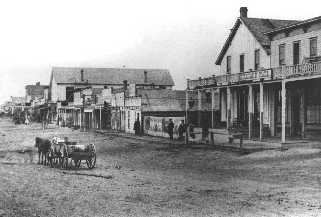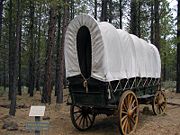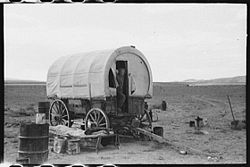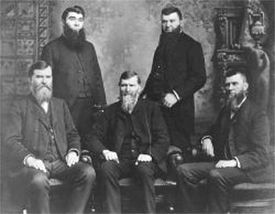| Dodge City, Kansas from Wikipedia, the free encyclopedia
EARLY HISTORY
The early history of Dodge city is as colorful as any
town in the American West.
ORIGINS
The first settlement in the area that became Dodge City
was Fort Mann. Built by civilians in 1847, Fort Mann was intended to provide
protection for travelers on the Santa Fe Trail. Fort Mann collapsed in
1848 after an Indian attack. In 1850, the U.S. Army arrived to provide
protection in the region and constructed Fort Atkinson on the old Fort
Mann site. The army abandoned Fort Atkinson in 1853. Military forces on
the Santa Fe Trail were reestablished further north and east at Fort Larned
in 1859, but the area around what would become Dodge City remained vacant
until after the Civil War. In 1865, as the Indian Wars in the West began
heating up, the army constructed Fort Dodge to assist Fort Larned in providing
protection on the Santa Fe Trail. Fort Dodge remained in operation until
1882.
The town of Dodge City can trace its origins to 1871 when
rancher Henry J. Sitler built a sod house west of Fort Dodge to oversee
his cattle operations in the region. Conveniently located near the Santa
Fe Trail and Arkansas River, Sitler's house quickly became a stopping point
for travelers. With the Santa Fe Railroad rapidly approaching from the
east, others saw the commercial potential of the region. In 1872, just
five miles west of Fort Dodge, settlers platted out and founded the town
of Dodge City. George M. Hoover established the first bar in a tent to
service thirsty soldiers from Fort Dodge. The railroad arrived in September
to find a town ready and waiting for business. The early settlers in Dodge
City traded in buffalo bones and hides and provided a civilian community
for Fort Dodge. However, with the arrival of the railroad, Dodge City soon
became involved in the cattle trade.
Cattle trade
The idea of driving Texas longhorn cattle from Texas
to railheads in Kansas originated in the late 1850s but was cut short by
the Civil War. In 1866, the first Texas cattle started arriving in Baxter
Springs in southeastern Kansas by way of the Shawnee Trail. However, Texas
longhorn cattle carried a tick that spread splenic fever among other breeds
of cattle. Known locally as Texas Fever, alarmed Kansas farmers persuaded
the Kansas State Legislature to establish a quarantine line in central
Kansas. The quarantine prohibited Texas longhorns from the heavily settled,
eastern portion of the state.
With the cattle trade forced west, Texas longhorns began
moving north along the Chisholm Trail. In 1867, the main Cow Town was Abilene,
Kansas. Profits were high, and other towns quickly joined in the cattle
boom. Newton in 1871; Ellsworth in 1872; and Wichita in 1872. However,
in 1876 the Kansas State Legislature responded to pressure from farmers
settling in central Kansas and once again shifted the quarantine line westward,
which essentially eliminated Abilene and the other Cow Towns from the cattle
trade. With no place else to go, Dodge City suddenly became Queen of the
Cow Towns.
A new route, known as the Great Western Cattle Trail,
or Western Trail, branched off from the Chisholm Trail to lead cattle into
Dodge City. Dodge City became a boomtown, with thousands of cattle passing
annually through its stockyards. The peak years of the cattle trade in
Dodge City were from 1883 to 1884, and during that time the town grew tremendously.
In 1880, Dodge City got a new competitor for the cattle trade from the
border town of Caldwell. For a few years the competition between the towns
was fierce, but there were enough cattle for both towns to prosper. Nevertheless,
it was Dodge City that became famous, and rightly so because no town could
match Dodge City's reputation as a true frontier settlement of the Old
West. Dodge City had more famous (and infamous) gunfighters working at
one time or another than any other town in the West, many of whom participated
in the Dodge City War of 1883. It also boasted the usual array of saloons,
gambling halls, and brothels established to separate a lonely cowboy from
his hard-earned cash, including the famous Long Branch Saloon and China
Doll brothel. For a time in 1884, Dodge City even had a bullfighting ring
where Mexican bullfighters imported from Mexico would put on a show with
specially chosen longhorn bulls.
As more agricultural settlers moved into western Kansas,
pressure on the Kansas State Legislature to do something about splenic
fever increased. Consequently, in 1885 the quarantine line was extended
across the state and the Western Trail was all but shut down. By 1886,
the cowboys, saloon keepers, gamblers, and brothel owners moved west to
greener pastures, and Dodge City became a sleepy little town much like
other communities in western Kansas.

Front Street, Dodge City, Kansas 1880 |
|
| Conestoga Wagon
The Conestoga wagon is a heavy, broad-wheeled covered
freight carrier used extensively during the United States Westward Expansion
in the late 1700s and 1800s. It was large enough to transport loads up
to 8 short tons (7 metric tons), and was drawn by 4 to 8 mules or 4 to
6 oxen.
History
The first Conestoga wagons appeared in Pennsylvania around
1725 and are thought to have been introduced by Mennonite German settlers
in that area, and its name came from the Conestoga Valley in that region.
In colonial times the conestoga wagon was popular for migration southward
through the Great Appalachian Valley along the Great Wagon Road. After
the American Revolution it was used to open up commerce to Pittsburgh and
Ohio. In 1820 rates charged were roughly one dollar per 100 pounds per
100 miles, with speeds about 15 miles (25 km) per day. The Conestoga, often
in long wagon trains, was the primary overland freight vehicle over the
Appalachians until the development of the railroad. Subsequently it played
a role in Western settlement, especially on the Santa Fe Trail, where ox
and mule teams could pull its vast cargo with fewer water stops. The Conestoga
wagon is a significant historical item that was used extensively during
the United States’ westward expansion in the late 1700s and 1800s. If it
had not been for the Conestoga wagons, the Westward Expansion would have
been greatly slowed for lack of transportation.
The Conestoga wagon was cleverly built. Its floor curved
upward to prevent the contents from tipping and shifting. Also for protection
against bad weather, stretched across the wagon was a tough, white canvas
cover. It was 16.5 feet in length and 4.5 feet in width.
Prairie schooners
The term prairie schooner is often used to replace Conestoga
wagon. These commercial wagons were much too huge, heavy, and hard to handle
to be used by families emigrating to Oregon, Utah, California,or Virginia
in the nineteenth century. Thus, the westward-bound emigrants’ conveyance
of choice was the smaller, lighter, farm-type wagon which could be drawn
by teams of fewer animals. Crammed inside these small wagons were supplies
for the 2,000-mile journey ahead, a few precious items from back East,
and tools to help establish their future homes in the West.
The emigrants themselves never called their wagons Conestoga
or prairie schooners. Nineteenth-century diaries and reminiscences reveal
that westering emigrants during the time of their journeys — the 1840s,
1850s, and 1860s — generally referred to their vehicles simply as "wagons"
or "waggons." Travelers crossing the prairie gazed at the lines of white-topped
wagons rumbling across the dying grass and described the wagons as "ships
upon the ocean," or ships on "rolling waves of green from horizon to horizon,"
or as resembling "dim sails crossing a rolling sea." But they never called
their wagons “prairie schooners.”
English adventurer Fred Ebb penned the almost magic words
in his journal, in 1860 during an overland trip to Utah, when he wrote
the wagon “is literally a "prairie ship: its body is often used as a ferry.”
A few emigrant diaries make references to "prairie schooners," but only
when describing the large, freight-bearing Conestoga wagons that accompanied
some military expeditions or commercial ventures. It was not until the
pioneers began penning (and romanticizing) their reminiscences during the
1870s and later — long after their migration to the West — that they began
calling their own simple wagons "prairie schooners." Even then, some authors
near the end of the century felt the term was unusual enough to feel it
necessary to explain that an emigrant's wagon "came to be known in those
days as a prairie schooner." |

A covered wagon replica at the
High Desert Museum, Bend, Oregon
.
.

A late example of a covered wagon in actual use
Idaho, 1940 |
|
| Studebaker From Wikipedia
Studebaker Corporation, or simply Studebaker, was a United
States wagon and automobile manufacturer based in South Bend, Indiana.
Originally, the company was a producer of industrial mining wagons, founded
in 1852 and incorporated in 1868 under the name of the Studebaker Brothers
Manufacturing Company. While Studebaker entered the automotive business
in 1902 with electric vehicles and 1904 with gasoline vehicles, it partnered
with other builders of gasoline-powered vehicles until 1911. In 1913, Studebaker
introduced the first gasoline-powered automobiles under its own “Studebaker”
brand name. Acquired in 1954 by Packard Motors Company of Detroit, Michigan,
Studebaker was a division of the Studebaker Packard Corporation from 1957
to 1962. In 1962, it reverted to its previous name, the Studebaker Corporation.
While the company left the automobile business in 1966, Studebaker survived
as an independent closed investment firm until 1967 when it merged with
Worthington to become Studebaker-Worthington Corp.
History
Henry Studebaker was a farmer, blacksmith, and wagon-maker
who lived near Gettysburg, Pennsylvania in the early 19th century. By 1860,
he had moved to Ashland, Ohio and taught his five sons to make wagons.
They all went into that business as it grew westward with the country.
Clement and Henry Studebaker Jr. became blacksmiths and foundrymen in South
Bend. They first made metal parts for freight wagons and later expanded
into the manufacture of complete wagons. John made wheelbarrows in Placerville,
California, and Peter made wagons in Saint Joseph. The site of John's business
is Chinas Historic Landmark #142. The first major expansion in their business
came from their being in the right place to meet the needs of the California
Gold Rush in 1849.
When the gold rush settled down, John returned to Indiana
and bought out Henry's share of the business. They brought in their youngest
brother, Jacob, in 1852. Expansion continued to support westward migration,
but the next major decrease came from supplying wagons for the Union Army
in the Civil War. After the war, they reviewed what they had accomplished
and set a direction for the company.
They reorganized into the Studebaker Brothers Manufacturing
Company in 1878, built around the motto of "Always give more than you promise."
By this time the railroad and steamship companies had become the big freight
movers in the east. So they set their sights on supplying farmers and others
with the means to move themselves and their goods. Peter's business became
a branch operation.
During the height of westward migration and wagon train
pioneering, half of the wagons were Studebakers. They made about a quarter
of them, and manufactured the metal fittings to sell to other builders
in Missouri for another quarter century.
Studebaker Automobiles 1897-1966
Studebaker experimented with powered vehicles as early
as 1897, choosing electric over gasoline engines. While it attempted to
manufacture its own electric vehicles from 1902 to 1912, the company entered
into a distribution agreement with two manufacturers of gasoline powered
vehicles: Garford of Elyria, Ohio, and the Everett-Metzger-Flanders (E-M-F)
Company of Detroit.
Under the agreement with Studebaker, Garford would receive
completed chassis and drivetrains from Ohio and then mate them with Studebaker
built bodies, which were sold under the Studebaker-Garford brand name and
at a premium price. Eventually, even the Garford built engines began to
carry the Studebaker name. However, Garford also built a limited number
of cars under its own name, and by 1907 attempted to increase production
at the expense of Studebaker. Once the Studebakers discovered what was
going on with their partner, John Moehler Studebaker enforced a primacy
clause, forcing Garford back onto the scheduled production quotas. The
decision to drop the Garford was made and the final product rolled off
the assembly line by 1911, leaving Garford to try it alone until it was
acquired by John North Willys in 1913.
Studebaker's marketing agreement with E-M-F was a different
relationship, one that John Studebaker had hoped would give Studebaker
a quality product without the entanglements found in the Garford relationship.
Unfortunately, this was not to be the case.
Under the terms of the agreement, E-M-F would manufacture
vehicles and the Studebakers would distribute them through their wagon
dealers. Problems with E-M-F made the cars unreliable, leading the public
to say that E-M-F stood for "Every Morning Fix-it."[citation needed] Compounding
the problems was the internal fighting between E-M-F's principal partners,
Mr. Everett, Mr. Flanders and Mr. Metzger. Eventually, two-thirds of the
trio left, leaving the bombastic Mr. Metzger to run the operation on his
own. J.M. Studebaker, unhappy with E-M-F's poor quality, gained control
of the assets and plant facilities in 1910. To remedy the damage done by
E-M-F, Studebaker paid mechanics to visit each unsatisfied owner and replace
the defective parts in their vehicles at a cost to the company of US$1
million.
Studebaker also began putting its name on new automobiles
produced at the former E-M-F facilities, both as an assurance that the
vehicles were well-built, and as its commitment to making automobile production
and sales a success. In 1911, the company reorganized as the Studebaker
Corporation.
In addition to cars, Studebaker added a truck line, which
in time, replaced the horse drawn wagon business started in 1852. In 1926,
Studebaker became the first automobile manufacturer in the United States
to open a controlled outdoor proving ground; in 1937 the company planted
5,000 pine trees in a pattern that when viewed from the air spelled "STUDEBAKER."
From the 1920s to the 1960s, the South Bend company originated
many style and engineering milestones, including the classic 1929-1932
Studebaker President and the 1939 Studebaker Champion. During World War
II, Studebaker produced the Studebaker US6 truck in great quantity and
the unique M29 Weasel cargo and personnel carrier. After cessation of hostilities,
Studebaker returned to building automobiles that appealed to average Americans
and their need for transportation and mobility.
However, ballooning labor costs (the company had never
had an official United Auto Workers (UAW) strike and Studebaker workers
and retirees were among the highest paid in the industry), quality control
issues, and the new car sales war between Ford and General Motors in the
early 1950s wreaked havoc on Studebaker's balance sheet. Professional financial
managers stressed short term earnings rather than long term vision. There
was enough momentum to keep going for another ten years, but stiff competition
and price cutting by the Big Three doomed the enterprise. There was also
a labor strike at the South Bend plant in 1962.
Merger with Packard
Hoping to stem the tide of losses and bolster its market
position, Studebaker allowed itself to be acquired by Packard Motor Car
Company of Detroit; the merged entity was called the Studebaker-Packard
Corporation. Studebaker's cash position was far worse than it led Packard
to believe and, in 1956, the nearly bankrupt auto-maker brought in a management
team from aircraft maker Curtiss-Wright to help get it back on its feet.
At the behest of C-W's president, Roy T. Hurley, the company became the
American importer for Mercedes-Benz, Auto Union, and DKW automobiles and
many Studebaker dealers sold those brands as well. In 1958, the Packard
name was discontinued, although the company continued to bear the Studebaker-Packard
name through 1962.
With an abundance of tax credits in hand from the years
of financial losses, at the insistence of the company's banks and some
members of the board of directors, Studebaker-Packard began diversifying
away from automobiles in the late 1950s. While this was good for the corporate
bottom line, it virtually guaranteed there would be little spending on
Studebaker's mainstay products, its automobiles.
The automobiles that came after the diversification process
began, including the ingeniously-designed compact Lark (1959) and even
the Avanti sports car (1963), were based on old chassis and engine designs.
The Lark, in particular, was based on existing parts to the degree that
it even utilized the central body section of the company's 1953 cars, but
was a clever enough design to be quite popular in its first year, selling
over 150,000 units and delivering an unexpected $28 million profit to the
automaker.
Hamilton, Ontario
On August 18, 1948, surrounded by more than 400 employees
and a battery of reporters, the first vehicle, a blue Champion four-door
sedan, rolled off of the Studebaker assembly line in Hamilton, Ontario,
Canada. The company was located in the former Otis-Fenson military weapons
factory off Burlington Street on Victoria Avenue North, which was built
in 1941. The Indiana-based Studebaker Corporation was looking for a Canadian
site and settled on Hamilton because of its steel industry. The company
was known for making automotive innovations and building solid, distinctive
cars. 1950 was its best year, but the descent was quick. By 1954, Studebaker
was in the red and merging with Packard, another troubled car manufacturer.
In 1963, the company moved its entire car operations to Hamilton. The Canadian
car side had always been a money-maker and Studebaker was looking to curtail
disastrous losses. That took the plant from a single to second shift -
48 to 96 cars daily.
The last car to roll off the line was a turquoise Lark
cruiser on March 16, 1966. Studebaker officially announced the shutdown
of its last car factory on March 4. It was terrible news for the 700 workers
who had formed a true family at the company, known for its employee parties
and day trips. It was a huge blow to the city, too. Studebaker was Hamilton's
10th largest employer at the time.
Non-Auto Businesses
Studebaker was involved in other areas of manufacture
besides automobiles. The Franklin Appliance Company manufactured Home Appliances
such as Refrigerators and such, until its sale to White Consolidated Industries.
Studebaker also owned and manufactured STP, Gravely Tractor,
Onan Electric Generators, and Clarke Floor Machine.

Studebaker
John Studebaker arrived in Placerville, CA. on August
31, 1853 at nineteen years old. He left for home with his fortune of $8000
in 1858 at the age of 25.
Some think that John had left part of his fortune behind.
Wheelbarrow
Johnny's Lost Gold |
Five Studebaker Brothers

top left ... Peter and Jacob
bottom left ... Clement, Henry and John |
You are probably wondering what this has to do
with anything. Well the wheel barrows built by John in the California gold
fields were called Studebakers and the wagons built by the Studebaker brothers
were called Conestogas Wagons.
|